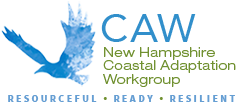July 23, 2020 | By: Steve Miller, GBNERR
I have been cleaning out my paper and electronic files, 18.5 years of work, files from hundreds of training events with development notes, reams of planning communications, flyers, agendas, evaluations, attendance lists as well as invoices; strategic plans, work plans, needs assessments, and reports as well as countless emails, files with ideas never realized, and memories and dreams everywhere. Time has flown and over 13,000 tide cycles have flowed in and out of Great Bay since I began working at the Great Bay National Estuarine Research Reserve as the Coastal Training Program Coordinator.
In this cleaning out I came across a copy of the letter I sent to partners inviting them to a meeting to begin the final stages of development of a municipal climate change workshop. This meeting resulted in the formation of the New Hampshire Coastal Adaptation Workgroup (NHCAW). The strength and skills of the diverse partners in the room, and the experience and successes of our collective work with the Natural Resources Outreach Coalition, resulted in the realization that there was a larger need beyond this one workshop. After a year of storming, CAW was officially formed and it is a credit to the “New Hampshire” way. NHCAW is made up of partners and stakeholders with diverse core strengths, who have worked together for decades on the ground, who understand the landscape and audience needs, and with the trust of each other that grows with shared work. We came together even though no one had climate adaptation in their job title or responsibilities; we came together because we knew the importance of the work and found the time to dedicate to it.
The work of CAW has evolved and changed with the increased knowledge base and understanding of the issues on both our part and on the part of our audiences, and with the development and availability of resources. From a time when no one had climate change or resilience in their job title, to a land scape with numerous people charged so, the effort has become more focused and effective. But within the evolution the constant has been the collaborative.
So how does NHCAW continue to evolve and lead in climate adaptation, mitigation, and resilience building? How does CAW best serve our audiences and our mission? I believe there needs to be some work within CAW, as the “CAW collaborative” first and foremost, on how CAW and our audience’s needs have, and will, continue to change and how CAW should adapt to these changes.
The collaboration that gives CAW its strength is not free. It requires the hard work of maintaining entwined relationships, with trust and open communication, dialog, and listening. It requires time. And as success brings more work, time becomes the limited resource. Don’t create un-needed organizational structure or procedures, don’t waste time on things that do nothing to advance the work or create efficiencies. And don’t try to plan every detail or have a prescribed path that does not allow for quick shifts in topics of need or services required by the audience, and misses the opportunities in front of you that come with the surprises.
I believe CAW needs to improve internal communications with all members on an equal basis but without the effort becoming an anchor. And I do not have the answer to how you do that. CAW is a national leader in a moderate scale functional collaboration, but it should never stop listening, watching, and learning from others in the field. Try not to get distracted by the shiny objects along this path.
Clearly each organization within CAW needs to demonstrate value and effectiveness and must get recognition for their work, embrace this reality. The collaborative framework does not negate this, but it can at times necessitate some nuance and sensitivity.
The success of CAW has been built on the collaborative; the money awarded to CAW proposals comes to the organizations who apply, in large part because of the knowledge on the national level of the CAW collaborative, again thanks to our collaborative NH way. Our ability to work together, our diverse skill base and resources to solve problems, and our past and current failures, growth, and successes are recognized and appreciated.
I wish you all continued success in this work. Enjoy the path; the destination comes sooner than imagined. Thank you for being part of CAW, for being a colleague, and taking on this work. May the challenges ahead be met with renewed enthusiasm and energy, and the expectation of surprises in the work not be disappointed.
Remember what they say about going fast or going far.
Sincerely,
Steve Miller
GBNERR CTPC
Photo: Sherry Godlewski
